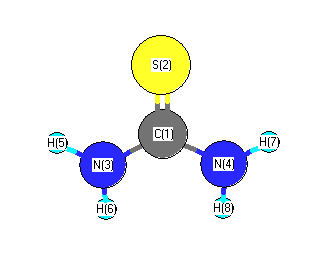Vibrational Frequencies calculated at HF/6-31G(2df,p)
| Mode Number |
Symmetry |
Frequency
(cm-1) |
Scaled Frequency
(cm-1) |
IR Intensities
(km mol-1) |
Raman Act
(Å4/u) |
Dep P |
Dep U |
|---|
| 1 |
A |
3973 |
3598 |
65.07 |
|
|
|
| 2 |
A |
3838 |
3475 |
35.85 |
|
|
|
| 3 |
A |
1803 |
1632 |
105.38 |
|
|
|
| 4 |
A |
1522 |
1378 |
360.42 |
|
|
|
| 5 |
A |
1149 |
1041 |
77.52 |
|
|
|
| 6 |
A |
797 |
722 |
35.37 |
|
|
|
| 7 |
A |
518 |
469 |
0.20 |
|
|
|
| 8 |
A |
495 |
448 |
3.72 |
|
|
|
| 9 |
A |
156 |
141 |
34.05 |
|
|
|
| 10 |
B |
3972 |
3596 |
78.21 |
|
|
|
| 11 |
B |
3829 |
3467 |
111.91 |
|
|
|
| 12 |
B |
1775 |
1607 |
274.84 |
|
|
|
| 13 |
B |
1560 |
1412 |
144.14 |
|
|
|
| 14 |
B |
1141 |
1033 |
13.56 |
|
|
|
| 15 |
B |
723 |
655 |
4.82 |
|
|
|
| 16 |
B |
653 |
592 |
28.65 |
|
|
|
| 17 |
B |
428 |
387 |
3.66 |
|
|
|
| 18 |
B |
310 |
281 |
438.30 |
|
|
|
Unscaled Zero Point Vibrational Energy (zpe) 14320.2 cm
-1
Scaled (by 0.9055) Zero Point Vibrational Energy (zpe) 12966.9 cm
-1
See section
III.C.1 List or set vibrational scaling factors
to change the scale factors used here.
See section
III.C.2
Calculate a vibrational scaling factor for a given set of molecules
to determine the least squares best scaling factor.
Charges, Dipole, Quadrupole and Polarizability
Charges from optimized geometry at HF/6-31G(2df,p)
Charges (e)
| Number |
Element |
Mulliken |
CHELPG |
AIM |
ESP |
| 1 |
C |
0.500 |
|
|
|
| 2 |
S |
-0.547 |
|
|
|
| 3 |
N |
-0.612 |
|
|
|
| 4 |
N |
-0.612 |
|
|
|
| 5 |
H |
0.333 |
|
|
|
| 6 |
H |
0.301 |
|
|
|
| 7 |
H |
0.333 |
|
|
|
| 8 |
H |
0.301 |
|
|
|
Electric dipole moments
Electric dipole components in Debye
(What's a Debye? See section
VII.A.3)
| |
x |
y |
z |
Total |
| |
0.000 |
0.000 |
-6.110 |
6.110 |
| CHELPG |
|
|
|
|
| AIM |
|
|
|
|
| ESP |
|
|
|
|
Electric Quadrupole moment
Quadrupole components in D Å
| Primitive |
|---|
| | x | y | z |
|---|
| x |
-34.784 |
0.735 |
0.000 |
| y |
0.735 |
-24.913 |
0.000 |
| z |
0.000 |
0.000 |
-28.636 |
|
| Traceless |
|---|
| | x | y | z |
|---|
| x |
-8.009 |
0.735 |
0.000 |
| y |
0.735 |
6.797 |
0.000 |
| z |
0.000 |
0.000 |
1.212 |
|
| Polar |
|---|
| 3z2-r2 | 2.424 |
|---|
| x2-y2 | -9.870 |
|---|
| xy | 0.735 |
|---|
| xz | 0.000 |
|---|
| yz | 0.000 |
|---|
|
Polarizabilities
Components of the polarizability tensor.
Units are
Å
3 (Angstrom cubed)
Change units.
| |
x |
y |
z |
| x |
3.725 |
-0.037 |
0.000 |
| y |
-0.037 |
6.021 |
0.000 |
| z |
0.000 |
0.000 |
8.347 |
<r2> (average value of r
2) Å
2
| <r2> |
100.394 |
| (<r2>)1/2 |
10.020 |
